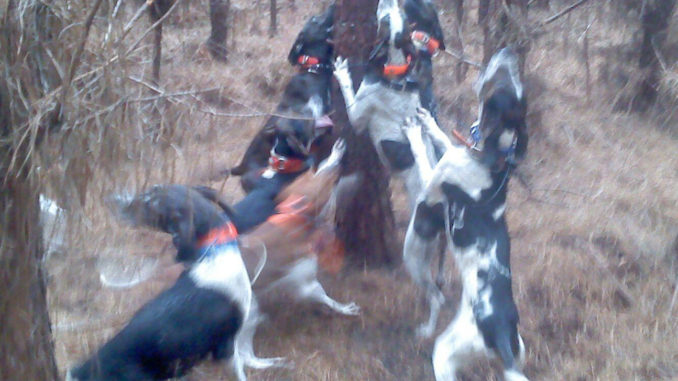
Hunting with hounds is a time-honored tradition where hunters rely on man’s best friend to flush, chase and/or locate game. From rabbits and deer to quail and grouse, there are few species were there is no opportunity for dogs to participate in one shape or fashion. Hunters can improve their chances for success and safety by following a few very important guidelines.
Hunting bears with dogs is by far the most-effective way to get a bear in close range of a lethal weapon. The best bear dogs have good noses and long legs that could be used for hunting feral hogs and deer. In North Carolina, popular bear hounds are a mixture of Plot, bluetick and Walkers. They track and will tree or completely surround a bear in the thickest cover, giving hunters enough time to slip in and put a shotgun charge into their cranial cavity.
The days of losing dogs should be in the past. Hunters should rarely ever lose their dogs with the development of GPS tracking collars and receivers that can show where each and every dog is at any time, often on an overlaid topo map. Additionally, GPS tracking allows hunters to determine where a bear may cross roads and trails.
When targeting bears, hunters will utilize a tried-and-trued method to make sure the bear is found and corralled quickly without creating excessive confusion. Typically, hunters will use a handful of good tracking dogs to discover the trail and the bear’s location. After these dogs find the bear, the handlers can send in the rest of the pack , be anywhere from 10 to 15 dogs.
For seasoned hunter Zach Lancaster of Haywood County, it is dangerous for the dogs to actively run the bear in a smaller pack of fewer than 10.
“They need at least 10 or 12 in the pack to protect themselves,” he said, explaining that dogs will become very aggressive towards the bear, and with fewer dogs, the bear has more time to injure dogs. With more dogs, the bear will try to fight dogs coming at him from all sides, leaving it less time to concentrate on any single dog.
“They can work together, and the dogs will have a lesser chance of getting badly injured,” Lancaster said.
Hunting bears with dogs may not seem complicated, but an indiscriminate release of dogs on a trail at the same time can work against harvesting a bear quickly and safely. Lancaster always has a plan and implements its with specific dog in sequence, depending on what stage the chase is in.
“Don’t free-cast them into a block; that will set them up for mistakes or put them on old tracks. Successful bear hunting is mostly based on dog handling. It is like a basketball team. Each dog has its own ability and should be turned loose at the right time,” he said.




Be the first to comment